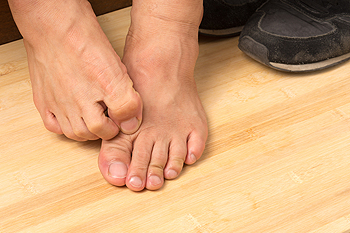Items filtered by date: October 2025
Foot Care for Diabetic Health

Proper foot care is essential for individuals with diabetes because poor circulation and nerve damage can lead to serious complications. Conditions such as diabetic foot ulcers and peripheral vascular disease can cause serious problems when foot care is neglected. Wearing shoes that fit properly, trimming toenails regularly, and keeping feet elevated can help prevent injuries and improve blood flow. A podiatrist plays a key role in managing diabetic foot health by checking circulation, detecting early signs of infection, and providing customized care plans. If you have diabetes, it is strongly suggested that you are under the care of a podiatrist who can help you to manage this serious condition.
Diabetic foot care is important in preventing foot ailments such as ulcers. If you are suffering from diabetes or have any other concerns about your feet, contact Dr. Milliron from Eternal Sole Foot and Ankle. Our doctor can provide the care you need to keep you pain-free and on your feet.
Diabetic Foot Care
Diabetes affects millions of people every year. The condition can damage blood vessels in many parts of the body, especially the feet. Because of this, taking care of your feet is essential if you have diabetes, and having a podiatrist help monitor your foot health is highly recommended.
The Importance of Caring for Your Feet
- Routinely inspect your feet for bruises or sores.
- Wear socks that fit your feet comfortably.
- Wear comfortable shoes that provide adequate support.
Patients with diabetes should have their doctor monitor their blood levels, as blood sugar levels play such a huge role in diabetic care. Monitoring these levels on a regular basis is highly advised.
It is always best to inform your healthcare professional of any concerns you may have regarding your feet, especially for diabetic patients. Early treatment and routine foot examinations are keys to maintaining proper health, especially because severe complications can arise if proper treatment is not applied.
If you have any questions, please feel free to contact our office located in Pace and Jay, FL . We offer the newest diagnostic and treatment technologies for all your foot care needs.
Inspect Your Feet Regularly for Abnormalities if You're Diabetic
Fungus and Athlete’s Foot
 Athlete’s foot can result in severe itching between the toes and on the bottom of the feet, and the toenails may become discolored and brittle. Athlete’s foot is caused by a fungus that lives and thrives in warm and moist environments. These can include public swimming areas, locker rooms, and shower room floors. The fungus typically enters the body through tiny cracks in the skin on the feet and is considered to be contagious. Preventative methods include wearing appropriate shoes in these areas, and it is also helpful to refrain from sharing towels, socks, and shoes. If you are afflicted with athlete’s foot, please consult with a podiatrist who can prescribe the correct treatments for this condition.
Athlete’s foot can result in severe itching between the toes and on the bottom of the feet, and the toenails may become discolored and brittle. Athlete’s foot is caused by a fungus that lives and thrives in warm and moist environments. These can include public swimming areas, locker rooms, and shower room floors. The fungus typically enters the body through tiny cracks in the skin on the feet and is considered to be contagious. Preventative methods include wearing appropriate shoes in these areas, and it is also helpful to refrain from sharing towels, socks, and shoes. If you are afflicted with athlete’s foot, please consult with a podiatrist who can prescribe the correct treatments for this condition.
Athlete’s Foot
Athlete’s foot is often an uncomfortable condition to experience. Thankfully, podiatrists specialize in treating athlete’s foot and offer the best treatment options. If you have any questions about athlete’s foot, consult with Dr. Milliron from Eternal Sole Foot and Ankle. Our doctor will assess your condition and provide you with quality treatment.
What Is Athlete’s Foot?
Tinea pedis, more commonly known as athlete’s foot, is a non-serious and common fungal infection of the foot. Athlete’s foot is contagious and can be contracted by touching someone who has it or infected surfaces. The most common places contaminated by it are public showers, locker rooms, and swimming pools. Once contracted, it grows on feet that are left inside moist, dark, and warm shoes and socks.
Prevention
The most effective ways to prevent athlete’s foot include:
- Thoroughly washing and drying feet
- Avoid going barefoot in locker rooms and public showers
- Using shower shoes in public showers
- Wearing socks that allow the feet to breathe
- Changing socks and shoes frequently if you sweat a lot
Symptoms
Athlete’s foot initially occurs as a rash between the toes. However, if left undiagnosed, it can spread to the sides and bottom of the feet, toenails, and if touched by hand, the hands themselves. Symptoms include:
- Redness
- Burning
- Itching
- Scaly and peeling skin
Diagnosis and Treatment
Diagnosis is quick and easy. Skin samples will be taken and either viewed under a microscope or sent to a lab for testing. Sometimes, a podiatrist can diagnose it based on simply looking at it. Once confirmed, treatment options include oral and topical antifungal medications.
If you have any questions, please feel free to contact our office located in Pace and Jay, FL . We offer the newest diagnostic and treatment technologies for all your foot care needs.
Morton’s Neuroma and Surgical Treatment Options

Morton’s neuroma is a painful condition caused by thickening of tissue surrounding a nerve between the third and fourth toes, often resulting in burning, tingling, or numbness. When conservative treatments are ineffective, surgery may be recommended. A neurectomy involves removing the affected nerve to relieve pain, while decompression surgery releases pressure on the nerve by cutting surrounding ligaments. Recovery time varies depending on the procedure, typically requiring several weeks to regain full function and return to normal activities. A podiatrist can evaluate the severity of the neuroma, discuss surgical and non-surgical options, and provide post-operative care to ensure proper healing. If you have pain in this part of your foot, it is suggested that you consult a podiatrist who can accurately diagnose Morton’s neuroma, and discuss surgical options with you.
Foot surgery is sometimes necessary to treat a foot ailment. To learn more, contact Dr. Milliron of Eternal Sole Foot and Ankle. Our doctor will assist you with all of your foot and ankle needs.
When Is Surgery Necessary?
Foot and ankle surgery is generally reserved for cases in which less invasive, conservative procedures have failed to alleviate the problem. Some of the cases in which surgery may be necessary include:
- Removing foot deformities like bunions and bone spurs
- Severe arthritis that has caused bone issues
- Cosmetic reconstruction
What Types of Surgery Are There?
The type of surgery you receive will depend on the nature of the problem you have. Some of the possible surgeries include:
- Bunionectomy for painful bunions
- Surgical fusion for realignment of bones
- Neuropathy decompression surgery to treat nerve damage
Benefits of Surgery
Although surgery is usually a last resort, it can provide more complete pain relief compared to non-surgical methods and may allow you to finally resume full activity.
Surgical techniques have also become increasingly sophisticated. Techniques like endoscopic surgery allow for smaller incisions and faster recovery times.
If you have any questions, please feel free to contact our office located in Pace and Jay, FL . We offer the newest diagnostic and treatment technologies for all your foot care needs.
Understanding Bunions and Their Causes

Bunions are bony bumps that form at the base of the big toe when the joint shifts out of alignment. They can be caused by a variety of factors, including genetics, wearing tight or narrow shoes, and arthritis. Other factors are foot injuries or abnormal foot mechanics, such as flat feet or overpronation. Symptoms include a visible bump on the side of the foot, redness, swelling, pain, and difficulty finding in comfortable footwear. The affected area may feel tender or stiff, and walking can become increasingly uncomfortable as the bunion worsens. A podiatrist can diagnose bunions through a physical examination and imaging tests like X-rays to assess the severity of the deformity. Treatment options range from conservative measures, such as padding, orthotics, and shoe modifications, to minimally invasive or traditional surgery, in more severe cases. Early care can help reduce pain and prevent progression. If you have the beginning signs of a bunion, it is suggested that you schedule an appointment with a podiatrist to discuss symptoms and develop an effective treatment plan.
If you are suffering from bunion pain, contact Dr. Milliron of Eternal Sole Foot and Ankle. Our doctor can provide the care you need to keep you pain-free and on your feet.
What Is a Bunion?
Bunions are painful bony bumps that usually develop on the inside of the foot at the joint of the big toe. As the deformity increases over time, it may become painful to walk and wear shoes. Women are more likely to exacerbate existing bunions since they often wear tight, narrow shoes that shift their toes together. Bunion pain can be relieved by wearing wider shoes with enough room for the toes.
Causes
- Genetics – some people inherit feet that are more prone to bunion development
- Inflammatory Conditions - rheumatoid arthritis and polio may cause bunion development
Symptoms
- Redness and inflammation
- Pain and tenderness
- Callus or corns on the bump
- Restricted motion in the big toe
In order to diagnose your bunion, your podiatrist may ask about your medical history, symptoms, and general health. Your doctor might also order an x-ray to take a closer look at your feet. Nonsurgical treatment options include orthotics, padding, icing, changes in footwear, and medication. If nonsurgical treatments don’t alleviate your bunion pain, surgery may be necessary.
If you have any questions, please feel free to contact our office located in Pace and Jay, FL . We offer the newest diagnostic and treatment technologies for all your foot care needs.

